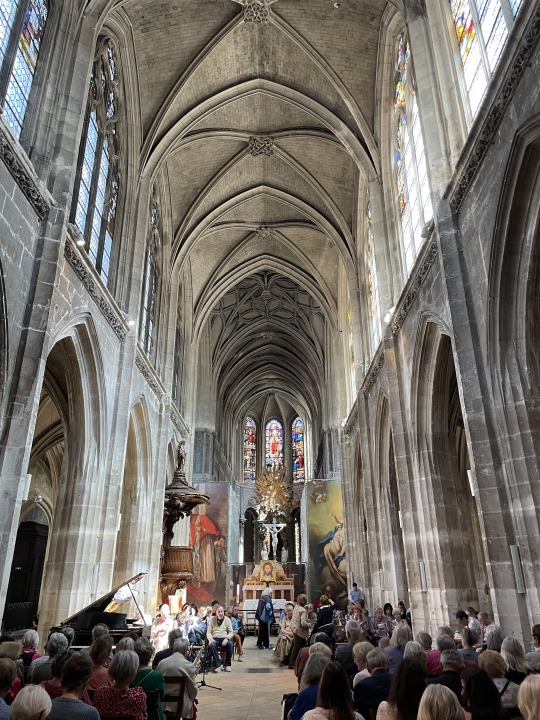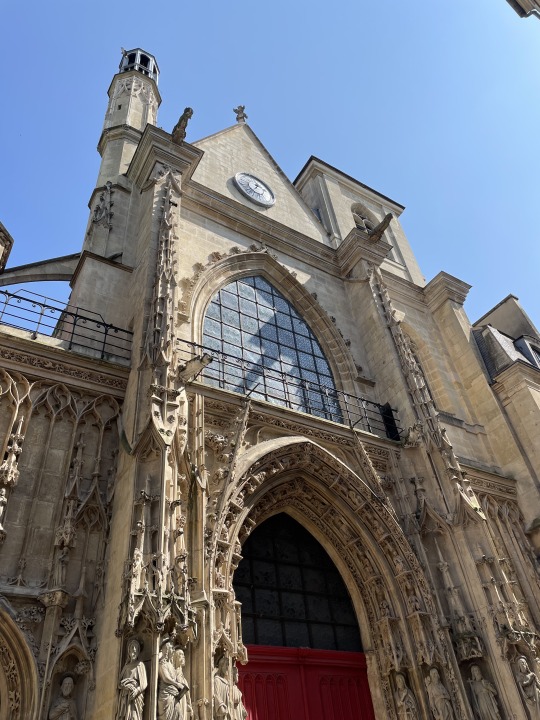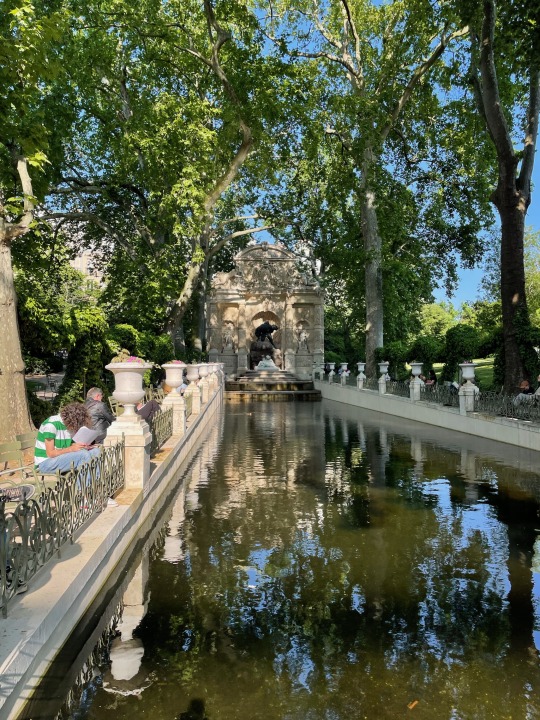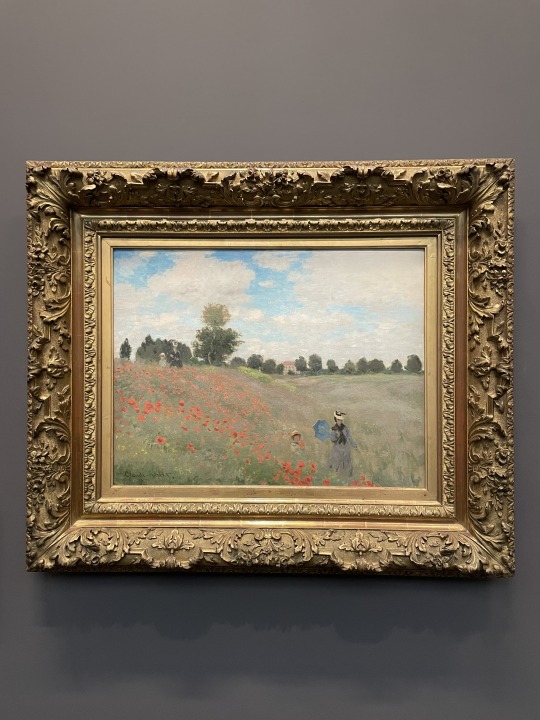Text
Historic Church and Religious Diversity
I love the great diversity of people from all backgrounds in Paris. It has allowed me to experience many different cultures in one city. It is extremely enriching to observe what practices many individuals incorporate into their daily lives. Growing up in a Christian home in West Michigan, I was not exposed to a significant amount of religious diversity in my own community. My grandparents are Italian and my dad was raised in the Roman Catholic church. My great grandfather on my mom’s side was a preacher and she was raised in the Protestant church. When my brother and I were born, my parents decided to commit to the Roman Catholic church, send my brother and I through faith fromation classes and first communion, and attend mass weekly. I have always had a strong faith and also enjoy seeing how others incorporate faith into their own lives!
Additionally, during our time in Paris, we had the privilege of experiencing a Roman Catholic mass and exploring a mosque. While I grew up in a Christian household and attend mass frequently, it was absolutely fascinating to experience a service in Paris at St. Eustache. The grandiosity of the beautiful cathedral left me in complete awe. The stained glass windows were stunning as the mid-morning sun shone through them and the ceiling reached an incredible height. I was also fascinated by the sheer size of the pipe organs and the beautiful melodies that reverberated around the church throughout mass. Although I was generally able to follow the order of the mass, it was extremely interesting to experience it in a different language. Aside from our class trips, I was able to explore Paroisse Saint-Merry on my own time. Even though this church is also Roman Catholic, it was siginificantly different from St. Eustache. While the church was incredibly beautiful, it was not quite as massive and grand as St. Eustache. I was able to visit it right before mass began during the afternoon of Sunday, May 28th. The church was under partial construction which greatly limitied my ability to view the altar, but its ceilings and architecture were magnificent. Stepping into any Parisian church immediately turns my mind to hisotry!
Our class trip to the Grande Mosquée de Paris was amazing! It was my first time entering a mosque and I was thrilled to take it all in. The architecture and designs were beautiful, created in a traditional, Moroccan style. As we stepped into the mosque, I immediately noticed how peaceful and tranquil the atmosphere was. It was extremely quiet, aside from birds chirping and leaves rustling in the central garden, in order for people to gather and focus on God. The intricate patterns of the colorful tiles, gorgeous fountains, and open-air spaces all added to the overall tranquility. Since the muslim population is substantial in Paris, it is extremely important for them to have a place to come gather and worship together.
The experience of visiting a mosque and visiting a French Catholic church varied greatly from my religious experience at home. While it was not what I am accustomed to, it only strengthed my faith and demonstrated that our amazing God is working across the globe in many ways. Being in a religiously diverse city allowed me to expand my West Michigan perspective and learn more about those that do not have the same customs or beliefs that I do. I was incredibly thankful to have the opportunity to grow in my own faith by experiencing it globally.
While a significant part of Paris’ population is religious in some form, there is a clear divide between the church and the government. French laicité calls for no ties between the government, public life, etc. and religious affiliations. Citizens are free to worship how they desire and participate in their chosen religion (or no religion). This idea encourages less division between the people and decreased emphasis on religious ties. While this idea generally satisfies most of the citizens, it may cause a decrease in individuality and the celebration of differences. It was fascinating to see how common Roman Catholicism is in this part of the world and how France approaches religious differences (701 words).


0 notes
Text
Parisian Lifestyle
As I have explored Paris for the past two weeks, I have loved witnessing French culture and observing major differences between France and the United States. One of the things that makes travel so fascinating is seeing how other people live! In general, I have observed an extremely more relaxed and easy-going culture and lifestyle in Paris than in the United States. In the United States, we seem to take pride in packed schedules and exceedingly busy days. Here in France, people are simply enjoying life more and not focusing on rushing around and checking as many boxes as possible.
In order to observe French culture beyond the city streets, I traveled to Le Jardin du Luxembourg to witness early evening activities of many. The park, absolutely gorgeous in its grandeur, was full of many people this past Thursday evening. Children played with small boats in the gorgeous fountain, couples walked hand-in-hand, teenagers fed small bits of pastry to the fish (which can not possibly be good for their digestive systems), friends chatted, and individuals wandered, took in the scenery, and soaked up the late May sun. I sat down on the edge of the fountain and wished that I could remain there for hours. I adored how full of life the park was on a normal Thursday evening at 6pm. It felt as if every folding chair in the park was occupied.
Additionally, I noted that while a park may be quieter around 6pm in the United States due to it being a common dinner time, it was bustling in France. During my first week in Paris, it was somewhat difficult to adjust to the later dinner time of 8pm, but I grew to love it. Dinner suddenly became the relaxing ending of my days in which I sat around with friends, chatted, and enjoyed a glass of wine paired with exquisite food. At home, I am used to snacking throughout the day, but Parisians do not commonly eat while doing other tasks. In France, eating is viewed as an experience that you are supposed to sit down and enjoy instead of rushing through it. Breakfast is enjoyed from about 7-10am, lunch from 12-2pm, and dinner from 8-10pm. During my time in Paris, my eating schedule has become a bit more regular and structured. Juice, coffee, or hot chocolate are commonly served with breakfast, water or soda at lunch, and generally wine with dinner. Since wine holds cultural significance in France, people utilize it as a way to socialize and enjoy their meal rather than to become intoxicated. Alcohol is dealt with much more casually in France and people seem to drink more responsibly!
Along with longer and more relaxing meals, the French people focus less on work and more on living a healthy and balanced lifestyle. Every employee must be limited to working 35 hours a week which generally equates to 7 hours a day for 5 days a week. This law allows citizens to disconnect from work and focus on family, friends, and hobbies that are more valuable. Aside from limiting working hours, France also takes care of its people by providing universal health care and offering assistance for all impoverished or homeless citizens. These laws prevent many people from being on the streets and allow more opportunities for potential employment. While French people may not receive as high of salaries as some United States citizens, it is much easier to live well with less money. This idea takes the pressure off of achieving a high-paying position and allows the middle class to be the most significant portion of the population. The idea that the government should respect and take care of its people dates back to the French Revolution and the liberty that the people fought for. Today’s social structure in France is a continuity of what the people have been fighting for all along; the common good and happiness of the majority! I am ready to stay for a while (665 words).

0 notes
Text
Experiencing Art Museums
Paris, known for its history, art, and architecture, has allowed me to expand my perspective and view things through the lens of an art historian. During my time in Paris, my class and I have had the opportunity to visit many museums including the Louvre, Musée d’Orsay, Musée Carnavalet, Musée de l’Orangerie, Palais de Porte Dorée, and Centres Georges Pompidou. Prior to our trip to Paris, we received a crash course on the art and history of the beautiful city. While it was extremely helpful to receive a background on many pieces before viewing them in person, I was thrilled to stand in front of and truly experience them. As we explored each museum, we listened to lectures from our professors which greatly helped us understand and analyze each piece of work. We discussed aspects that contributed to each piece of art such as line, scale, space, composition, medium, and pattern.
Additionally, each museum had something unique to offer and we were able to see a great variety of work from realism and romanticism to contemporary art. Especially in the Musée Carnavalet, I loved being able to wander from room to room and travel through many years of French history through artwork. In the Louvre, I was in complete awe of seeing multiple Davids in person. The sheer scale and intricacy of David’s work is incredible. While the Louvre was extremely expansive and housed incredible work, it was overwhelming and may have been one of my least favorite museums we visited. Overall, I was underwhelmed by the Louvre and the Mona Lisa may not have lived up to the hype or deserved a long line for a closer view. My favorite museums were smaller, quieter, more peaceful ones that allowed us to truly experience the art work and have thorough conversations.
While the Musée d’Orsay was neither small nor quiet, it housed some of my most favorite pieces. As we viewed many different types and styles of art throughout our trip, I came to the conclusion that impressionist painting was by far my favorite. I had always been struck by the beauty of Monet’s paintings in prints and photographs, but to see them in person simply took my breath away. Monet depicts beautiful, peaceful settings that do not require much analysis, but simply enjoyment for the viewer. Monet’s Poppies, an oil on canvas, is especially beautiful to me. I love the simplicity of the painting and the depiction of beautiful moments from everyday life. The brush strokes are evident and there are no harsh lines. The Poppies are extremely appealing to the eye. I love the splash of color that the poppies provide in the lush meadow and the depth that I am able to perceive based on the sizes of the trees and figures. I could stare at and be calmed by Monet’s Poppies for hours.
This incredible art history focused May Term has completely altered and expanded my perspective on art and the world. Not only have I learned how to navigate Paris and further my skills as a global citizen, but I have also gained a greater appreciation for art. Prior to the trip, I was solely excited about being in Paris, but I grew to love our class time and trips to museums. Now, rather than staring at and being confused by a piece of artwork, I am able to analyze it and consider possible interpretations. Our world would be bland and lifeless without art. I am grateful that my knowledge of art and how it ties to and reflects history has greatly expanded (598).

0 notes
Text
Pere Lachaise Cemetery
As my classmates and I emerged from the metro and began strolling down the street, we soaked up the warm May sun on our skin and took in the noises of the city. We wandered towards Pere Lachaise Cemetery in the 20th arrondissement of Paris, France. As we entered the gate of the cemetery, a wide cobblestone street and a dramatic landscape displayed monstrous gravestones dating back hundreds of years. The gravestones of the winding streets and narrow paths were adorned with moss, engravings, and delicately placed flowers in order to remember the particular lives lost.
While I weaved and wandered through the cemetery, I was particularly struck by the simultaneous beauty and eeriness of my surroundings. The lush trees, bright flowers, uneven cobblestones, and warm sunshine sharply contrasted with the crumbling gravestones, ominous presence of corpses, and cawing of the crows. The intricacy and sheer size of the tombs exceeded anything I had seen before. The beauty of the tombs honored and memorialized the lives of many and recognized their importance. Many individuals sat and read on benches, taking in the solemn peacefulness of their surroundings.
The intersection of characteristics of a somber graveyard and a beautiful park clashed while fitting right into place. I felt uneasy smiling and exploring with friends as some individuals mourned the loss of loved ones. The emergence of Pere Lachaise cemetery as somewhat of a tourist destination and lovely park almost felt insensitive to those who wished to mourn and remember in peaceful silence. The size, significance, and quantity of tombs made me feel small and insignificant as I pondered the perpetuity and non-perpetuity of life itself. An unexpected and overwhelming sense of calm coursed through me as I observed the beautiful resting place of many. As I stood next to the graves of individuals such as Oscar Wilde, Jacques Louis David, and Georges Haussmann, I was amazed by my proximity to individuals that had had an immensely significant impact on the history of France and the world.
As I wandered down a narrow path in the 11th section of the Pere Lachaise Cemetery, I was drawn to a beautiful tomb adorned with wildflowers and overgrown with weeds. The tomb was dedicated to Alexandre Brongniart who was born in Paris on February 5th, 1770, and died on October 7th, 1847. As I conducted a brief Google search on Brongniart, his impact on the world became extremely evident. He filled the roles of a chemist, paleontologist, mineralogist, zoologist, and paleontologist. Brongniart’s work and collaboration with Georges Cuvier on the geology of Paris’ surrounding areas lead to many discoveries. Additionally, he founded the Musée National de Céramique-Sèvres and became the director of the porcelain manufacturing that occurred at Sèvres. Brongniart served as a professor and instructor for many years and spread his knowledge of science and history. His tomb appeared untouched and unmanicured as if lost in time. The mass of tombs allowed many to be mixed in and simply forgotten as tourists bustled past to visit those of more well-known individuals. I would love to return to the cemetery, once again, to take in the diversity of the tombs and the incredible scenery that honors those who have passed (533 words).

2 notes
·
View notes